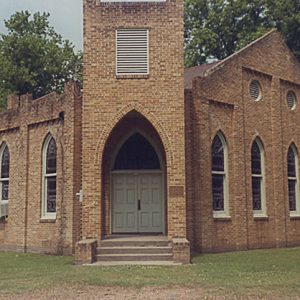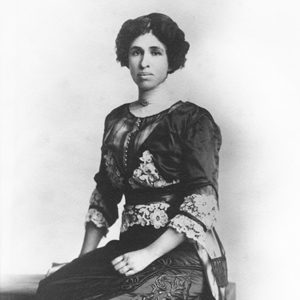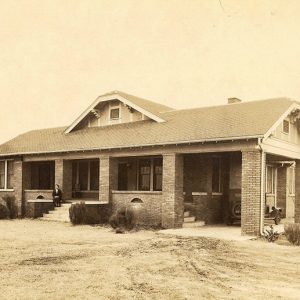calsfoundation@cals.org
Charline Woodford Beasley Person (1876–1951)
Charline Woodford Beasley Person ran a 5,000-acre cotton plantation in Miller County, Arkansas, after the death of her husband. Person was an active community and church leader, helping build the community church in Garland (Miller County) and steering her hometown through the Great Depression. She was also the only woman chosen to represent Arkansas at the St. Louis Exposition of 1926.
Charline Woodford Beasley was born on December 2, 1876, in Lewisville (Lafayette County), the daughter of Charles Hunter Beasley and Lucy Lungren Beasley. Beasley attended Lewisville School, and she was not quite seventeen when she married Levin King Person Jr. (1862–1911) in “Old Lewisville” in 1893. They had three children.
In January 1911, Levin Person died suddenly from a stroke. His death forced his wife to run the family business. By 1914, Charline Person was heavily in debt, the property was run down, and her workers were going hungry. “Miss Charline,” as she was known, had no business experience. It was said that she had never even signed a check before having to take over the plantation.
However, with prices rising during World War I, Person began making money in the cotton trade. By the mid-1920s, she had more than 100 families working for her, including white, African-American, and Mexican laborers. In December 1925, a representative of the St. Louis Southwestern Railway Company (a.k.a. the Cotton Belt) wrote to her, saying that she was the most successful woman he knew of on the Cotton Belt System. In February 1926, Person was featured at the Women’s National Exposition in St. Louis, Missouri. In honor of Person’s accomplishments, the railway constructed an exhibit showing a miniature field of cotton with several bales in the background. Person attended the exhibit as the Cotton Belt’s representative (the only woman from Arkansas so chosen). In a circular issued by the Cotton Belt Line concerning the St. Louis Exposition, it was reported that Person was doing half a million dollars in business every year. She was called a woman of “dynamic force and wide influence” and the “most prominent woman cotton planter in Arkansas.”
The Person farm was extensive, consisting of several plantations comprising more than 5,000 acres, most of them under cultivation. Person ran not just the plantation lands but also a general store located in town. She also did her own housekeeping, raised chickens, and tended a garden. She rode on horseback with the overseers who handled the details of plantation management; by the mid-1920s, she was making her rounds in an automobile. In addition to her cotton land, she also had property devoted to timber and pecan trees. However, she said she did not like growing corn because it was more prone to theft.
Person ran a ferry across the Red River from Garland, was president of the Garland Levee District, served as secretary of Drainage District No. 2, was a majority stock holder of a cotton gin, and directed the Bank of Garland. She assisted Henderson-Brown College when it almost closed due to lack of funds and was also active in the Red Cross.
The mid-1920s was a boom time for Person and the rest of the country, but in October 1929, the stock market crashed. By 1931, the Great Depression was in full swing, and communities that had traditionally relied on private charity rather than the government were overwhelmed. Person did what she could to help those in need. In 1931, she wrote to the Democrat of Wayne, Nebraska, to express her appreciation for a donation of 300 chickens for Garland. Person took charge of distributing the chickens to people who had traveled as far as fifteen miles on horseback and in wagons to receive them. She also lamented that the banks were not lending enough money to landowners. The Red Cross, she noted, was some help but could only do so much.
During the Depression, she helped raise funds to build and maintain the Garland Community Church (where she played piano and taught Sunday school). After World War II, boom times came again, and Person remained active in local affairs. In 1949, the Texarkana Gazette said that the Person name in Garland was second to none. By then, Person was retired.
On March 22, 1951, she died from an aneurism at Texarkana Hospital. She is buried in Wilson Cemetery in Lewisville next to her husband.
In 1984, Person was chosen to be among the women featured in an exhibit titled “Women of Arkansas” at the World’s Fair in New Orleans, Louisiana. The exhibit was a springboard for a larger exhibit on women at the Arkansas Sesquicentennial celebration that took place in 1986.
For additional information:
Arkansas Women’s History Institute Collection. Center for Arkansas History and Culture. University of Arkansas at Little Rock, Little Rock, Arkansas.
Charline Person Papers. Center for Arkansas History and Culture. University of Arkansas at Little Rock, Little Rock, Arkansas.
“Woman Is One of the State’s Most Successful Planters.” Arkansas Gazette, March 9, 1926, p. 11.
Colin Edward Woodward
Center for Arkansas History and Culture
 Early Twentieth Century, 1901 through 1940
Early Twentieth Century, 1901 through 1940 Community Church in Garland
Community Church in Garland  Charline Person
Charline Person  Charline Person Home
Charline Person Home 




Comments
No comments on this entry yet.